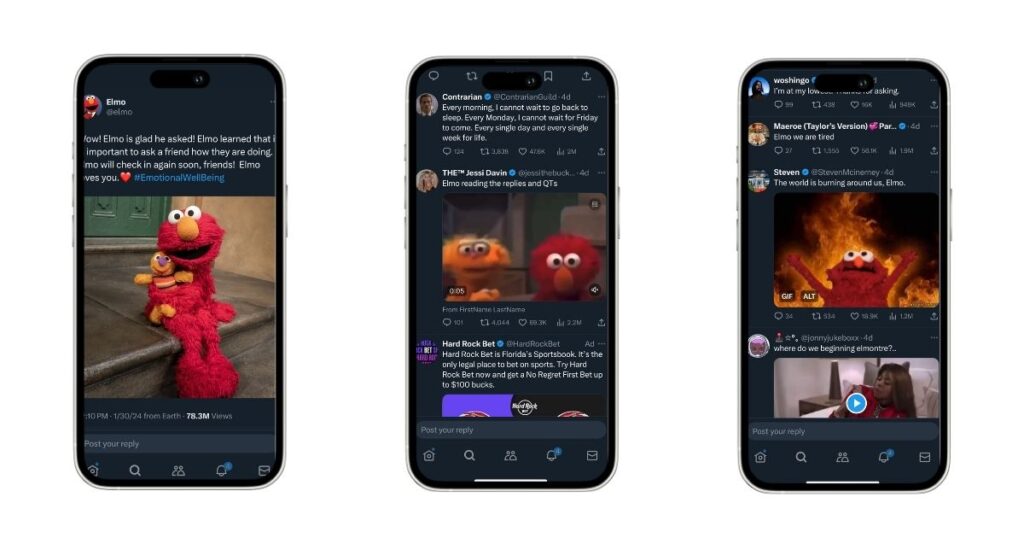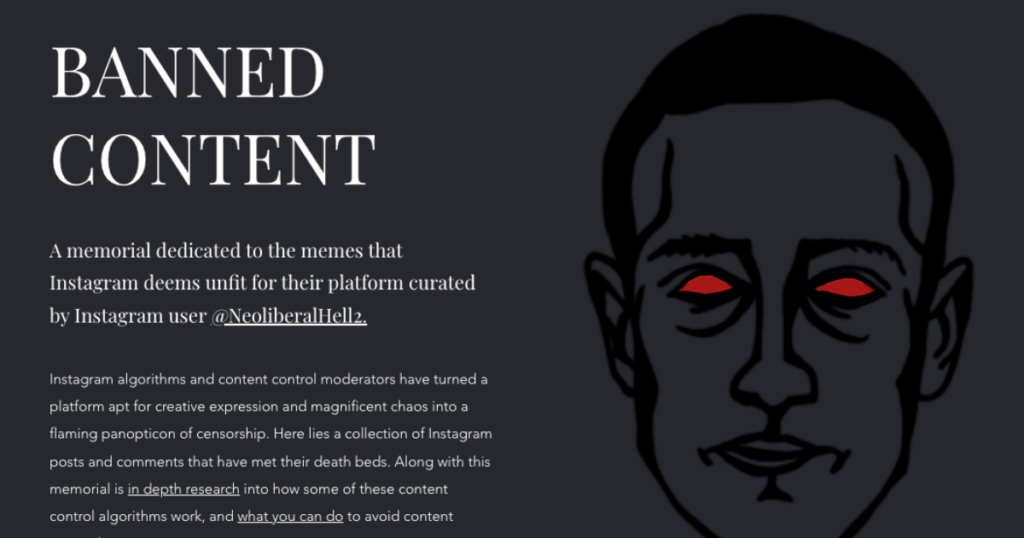Unlocking Algospeak: How Authenticity Triumphs in the Face of Censorship

Reed Berglund is a passionate advocate for wellness and an…
In our ever-evolving digital landscape, there’s a phenomenon taking shape that has captured our attention here at Breathe—a concept known as “Algospeak.” This term might not have been on my radar until my friend Sergio introduced it to me after Taylor Lorenz of the Washington Post dropped her piece on the topic back in April ’22. Let me tell you, it blew my mind. This intriguing concept has since resonated deeply with our mission at Breathe, which is all about connecting communities through health-focused content and events.
Elmo’s Intriguing Question
In a world where the norm is to politely deflect when someone inquires, “How are you doing?” Elmo’s genuine curiosity broke through the façade. It all unfolded on X (formerly known as Twitter), and it left us to figure out what to do next. The response to Elmo’s query was nothing short of overwhelming and has revealed a larger movement brewing on social platforms— “algospeak.”
In this article, we’ll dive deep into the world of Algospeak and explore its significance in today’s digital landscape. We’ll examine how this phenomenon is driven by the younger generation, particularly Gen Z, as they ingeniously find ways to circumvent content moderation filters on social media platforms. As we journey through the intricacies of Algospeak, we’ll uncover its nuances, implications, and its profound connection to the broader conversations about loneliness and mental health that have been sweeping across the internet.
The Etiquette of “How Are You Doing?”
Elmo really has us I’ve been thinking about this seemingly innocuous question “How are you doing?” that we toss around like a hot potato in social situations. It’s like the small talk Olympics, where nobody really expects a detailed emotional breakdown in response. It’s more of a social ritual than a genuine curiosity. Can you imagine a dinner party where all the guests dropped into your comments section with raw, dark answers?

This week, we didn’t have to imagine a world where this social etiquette of surface-level responses prevailed. The responses to Elmo’s post on Twitter have done all the imagining for us. It’s as if the floodgates of authenticity burst open, and people didn’t hold back. The world as we know it seemed to be unraveling, and it reflected in the replies:

“The world is burning around us, Elmo,” someone wrote. Even Oreo Cookies, of all things, jumped into the mix with a response like, “We’re out of milk. Do the math.” It was a moment when oversharing became the norm, and the humor and stark honesty in these responses hit a fever pitch.
In a way, this unexpected outpouring of raw, honest, and sometimes dark sentiments following Elmo’s simple question highlighted the humor in the contrast between our usual social etiquette and the unfiltered truth we often keep to ourselves. It made me realize how easily we navigate the delicate dance of small talk and pleasantries in our daily interactions, even as we carry deeper emotions beneath the surface.
Algospeak in the Digital Landscape
What’s Algospeak, Anyway?
In simple terms, Algospeak is like the secret handshake of the digital world. It’s the clever way people have found to communicate without setting off the alarms of content moderation on social media platforms. Think of it as a high-stakes game of wordsmithing, where users use coded language to say what they really mean without the algorithmic watchdogs catching on.
@danhoodpod Drunk in the dark is dangerous #podcast #funny #seggs #women #periods ♬ Polozhenie – Izzamuzzic Remix – Скриптонит
To understand Algospeak, it’s worth taking a step back and drawing a parallel to a concept with ancient origins—Aesopian language. The term “Aesopian language” harks back to the allegorical writings of the ancient Greek fabulist Aesop. In those tales, Aesop cleverly wove hidden messages and moral lessons into his stories, making them accessible to those who could decipher the deeper meaning. Much like Aesop’s allegories, Algospeak operates in a similar vein, allowing those in the know to communicate discreetly while maintaining an innocent façade for outsiders.
Cracking the Code
Now, let’s take a closer look at how Algospeak operates in practice. One striking example is the term “unalive.” This seemingly innocuous word carries a much heavier meaning in the world of Algospeak—it refers to death by suicide or homicide. What makes “unalive” particularly clever is its adaptability; it can function both as an adjective and a verb, seamlessly blending into conversations while concealing its deeper connotations.
But why resort to such linguistic acrobatics? The answer lies in the digital terrain where algorithms reign supreme. Sites and apps, in their quest to maintain safe and moderated environments, deploy automated systems that censor or down-rank posts containing explicit or violent content. To navigate this digital minefield, social media users have ingeniously crafted phrases like “unalive” and “mascara” (used to allude to sexual assault) to evade these algorithms’ watchful eyes.
@etymologynerd It's simultaneously so dystopian and so cool that a new way of writing has emerged to avoid AI censorship #linguistics #language #algospeak #etymology ♬ original sound – etymologynerd
The Need for Algospeak: A Heartbreaking Reality
The poignant reality of Algospeak’s necessity becomes all too clear when we consider cases like that of Chase Nasca, a Long Island teenager who tragically took his own life after encountering disturbing content on TikTok. Chase’s parents, Dean and Michelle Nasca, openly wept during a harrowing hearing on Capitol Hill. US Rep. Gus Bilirakis (R-Fla.) confronted TikTok CEO Shou Zi Chew, placing the blame squarely on the platform.
“Your company destroyed their lives,” Bilirakis declared, his voice filled with emotion. He recounted how Chase’s “For You” page, intended to curate content based on user interests, became a window into the darkest corners of despair. The unsolicited videos of violence and suicide that Chase encountered on TikTok ultimately had devastating consequences.
In the face of such heart-wrenching stories, it becomes evident that Algospeak isn’t merely a linguistic curiosity—it’s a lifeline for those who seek to discuss sensitive topics without falling victim to algorithmic censorship. While it’s a testament to human ingenuity, it’s also a sobering reminder of the profound impact digital platforms can have on real lives. For those interested in exploring more ways to enhance personal well-being and embrace self-care practices, consider indulging in HydraFacials for a flawless skin experience. These treatments offer a luxurious approach to skincare, helping you discover the top 10 places for your best facial in San Francisco to be further rejuvenated and aligned as you navigate the complexities of modern life.
Creators Are One Step Ahead
Amidst the evolving landscape of Algospeak, a remarkable phenomenon has emerged. It’s a phenomenon where the community, especially prominent TikTok creators, has united in a concerted effort to outsmart the content moderation systems deployed by various platforms. Lorenz’s piece shed light on this very community-driven initiative, highlighting how these creators collaborate by curating extensive lists of words they suspect might trigger the app’s stringent moderation algorithms.

These shared Google Docs have become digital bastions, collectively defending against the ever-watchful eyes of content censorship. The creators’ dedication and determination shine through as they meticulously dissect and analyze what words are considered problematic by the platform. It’s akin to a digital think tank, where they piece together the puzzle of content moderation, all in a bid to preserve the authenticity of their voices in a world where algorithms cast a long shadow.
Conclusion
What stands out amidst the intricacies of Algospeak is its underlying message—a message that reverberates in the responses to Elmo’s check-in and the countless instances of coded communication we’ve encountered. It’s a cry for help.
The Craving for Connection
Algospeak underscores a fundamental truth—people are longing for connection and support. Elmo’s simple question ignited a conversation that laid bare the complex emotions and challenges many of us face. The onus falls upon us to heed this call for support and empathy, to carry the conversation forward in a positive and constructive direction.
It’s a reminder that, beneath the coded language and algorithmic filters, we are all human, seeking understanding, compassion, and a listening ear. Let us embrace this authenticity, for it is in these shared moments of vulnerability and truth that we truly connect as a digital community.
Reed Berglund is a passionate advocate for wellness and an embodiment of the active lifestyle. As a former college athlete who played basketball for the UNLV Running Rebels, he's lived a life deeply immersed in body movement and sports. Reed's enthusiasm for staying active extends far beyond the basketball court. He's an avid surfer, wakeboarder, skier, basketball and tennis enthusiast, and an emerging padel player. His love for holistic well-being also includes a dedication to cold plunges and contrast therapy, embracing these practices to optimize recovery and vitality. In his role as the founder of Breathe, Reed brings his extensive experience in wellness and his unwavering commitment to helping individuals discover their path to a healthier, more mindful life. His personal journey and multifaceted fitness background inspire his vision for Breathe as a platform that empowers urban dwellers to explore, experience, and embrace well-being in all its forms. Reed's current focus lies in the realm of flexibility, a key component in his fitness journey to extend the longevity of his active lifestyle. Through Breathe, he aims to share his passion, knowledge, and insights with a vibrant community of wellness enthusiasts, experts, and storytellers, collectively working toward a healthier and happier world.


